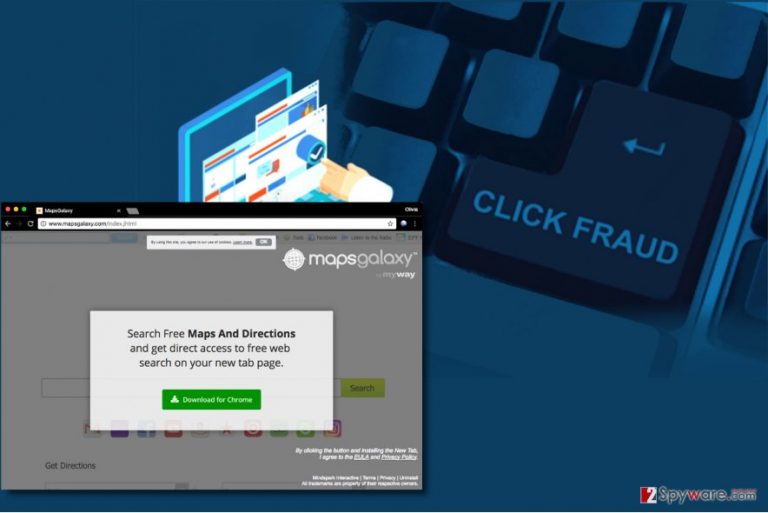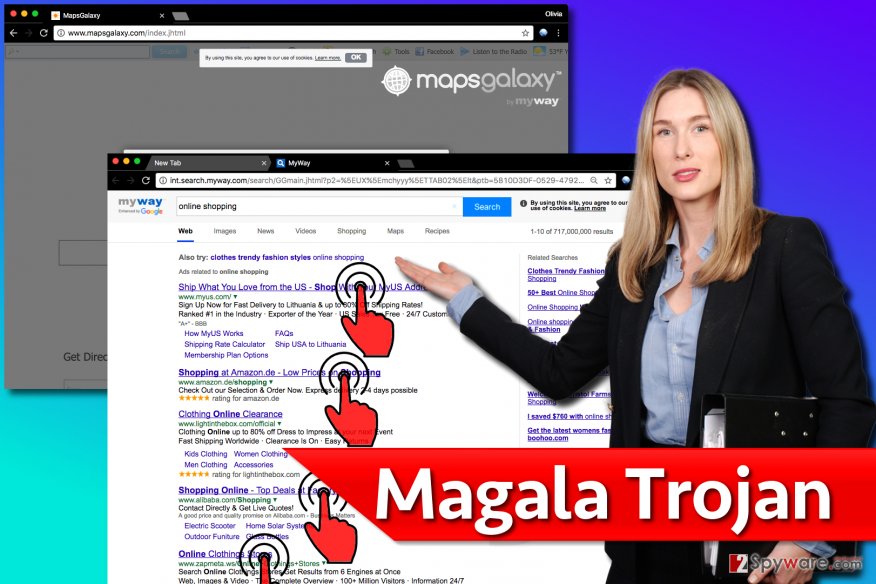Magala virus (Virus Removal Instructions) - Free Instructions
Magala virus Removal Guide
What is Magala virus?
Magala Trojan exploits victim's computer to generate pay-per-click revenue

Magala Trojan is a computer virus that targets Windows OS and uses virtual desktops to click on ads in search results. The virus infects Internet Explorer 9 and all higher versions of this browser. It is a must to remove Magala Trojan as soon as possible because it is a deceptive click-fraud[1] program.
Once installed on the system, Magala virus launches a virtual desktop and installs an infamous browser toolbar called MapsGalaxy. This extension is a product of a developer that has created a lot more potentially unwanted programs (PUPs) such as Screen Addict, EmailFanatic, or From DOC to PDF. Once the extension is installed, IE’s homepage gets switched to a customized version of hp.myway.com search site.
The Trojan then addresses its Command & Control server to download a file with a list of search queries. Magala Trojan viruses then enters each of these queries into the aforementioned search engine. Following that, it finds the first ten search results and successively clicks on each of them. To enter these websites, the Trojan employs IHTMLDocument2[2], a Windows interface that allows using DOM tree.
Knowing that search engines always push sponsored results to the top of the page, there is no doubt what is the aim of this click-fraud Trojan. It initiates visits to these promoted websites via the MapsGalaxy search engine to generate pay-per-click revenue for the developers of it.
The Trojan is extremely dangerous because it clicks on search results randomly, without checking their reliability. According to experts, the virus earns about 0.07 USD per click on a sponsored search results, meaning that a thousand successful clicks earn 2.2 USD. The virus only needs to perform 5000 clicks per day to earn approximately $350.

Of course, such activities will slow down victim’s computer since the virus continuously uses the Internet connection. To put an end to such shady activities of this virus, we highly recommend using FortectIntego for Magala removal. You can also employ tools like Malwarebytes.
Current reports show that the malware has affected USA, Russia, France, Germany[3], Australia, China, India, and UK citizens mostly.
Protect your PC from the Trojan
Typical Trojans are distributed via malicious spam, so you have to remember to be careful and avoid opening unsolicited junk mail. Never interact with the content of emails that come from unknown people or companies. Remember that logos of legitimate companies also do not indicate that the email originates from a trustworthy source. Criminals can easily forge these.
Malicious viruses can also be distributed via malvertising, illegal software packs, and other ways. To protect your PC from Magala malware, we highly recommend you to bypass questionable Internet websites and never download shady files or programs from the Internet.
Speaking of free software, we must mention that attempting to obtain a paid software for free is an illegal action. Besides, when installing free software, make sure that you choose Custom/Advanced settings and deselect all additional programs added to your preferred software.
Remove Magala Trojan virus
The right way to remove Magala virus is to employ a powerful anti-malware software. If you have an antivirus software, you can use it to delete the Trojan. However, if you noticed some suspicious extensions or potentially unwanted programs in your PC, you might want to run an additional scan using anti-spyware software like FortectIntego.
We do not recommend you to try to find and uninstall malware manually. This way, you can do more harm than good. Therefore, use an automatic spyware/malware removal software to perform a professional Magala removal.
Getting rid of Magala virus. Follow these steps
Manual removal using Safe Mode
To successfully delete Magala Trojan, restart you PC into Safe Mode first. Then run your security software to take care of this virtual threat.
Important! →
Manual removal guide might be too complicated for regular computer users. It requires advanced IT knowledge to be performed correctly (if vital system files are removed or damaged, it might result in full Windows compromise), and it also might take hours to complete. Therefore, we highly advise using the automatic method provided above instead.
Step 1. Access Safe Mode with Networking
Manual malware removal should be best performed in the Safe Mode environment.
Windows 7 / Vista / XP
- Click Start > Shutdown > Restart > OK.
- When your computer becomes active, start pressing F8 button (if that does not work, try F2, F12, Del, etc. – it all depends on your motherboard model) multiple times until you see the Advanced Boot Options window.
- Select Safe Mode with Networking from the list.

Windows 10 / Windows 8
- Right-click on Start button and select Settings.

- Scroll down to pick Update & Security.

- On the left side of the window, pick Recovery.
- Now scroll down to find Advanced Startup section.
- Click Restart now.

- Select Troubleshoot.

- Go to Advanced options.

- Select Startup Settings.

- Press Restart.
- Now press 5 or click 5) Enable Safe Mode with Networking.

Step 2. Shut down suspicious processes
Windows Task Manager is a useful tool that shows all the processes running in the background. If malware is running a process, you need to shut it down:
- Press Ctrl + Shift + Esc on your keyboard to open Windows Task Manager.
- Click on More details.

- Scroll down to Background processes section, and look for anything suspicious.
- Right-click and select Open file location.

- Go back to the process, right-click and pick End Task.

- Delete the contents of the malicious folder.
Step 3. Check program Startup
- Press Ctrl + Shift + Esc on your keyboard to open Windows Task Manager.
- Go to Startup tab.
- Right-click on the suspicious program and pick Disable.

Step 4. Delete virus files
Malware-related files can be found in various places within your computer. Here are instructions that could help you find them:
- Type in Disk Cleanup in Windows search and press Enter.

- Select the drive you want to clean (C: is your main drive by default and is likely to be the one that has malicious files in).
- Scroll through the Files to delete list and select the following:
Temporary Internet Files
Downloads
Recycle Bin
Temporary files - Pick Clean up system files.

- You can also look for other malicious files hidden in the following folders (type these entries in Windows Search and press Enter):
%AppData%
%LocalAppData%
%ProgramData%
%WinDir%
After you are finished, reboot the PC in normal mode.
How to prevent from getting trojans
Do not let government spy on you
The government has many issues in regards to tracking users' data and spying on citizens, so you should take this into consideration and learn more about shady information gathering practices. Avoid any unwanted government tracking or spying by going totally anonymous on the internet.
You can choose a different location when you go online and access any material you want without particular content restrictions. You can easily enjoy internet connection without any risks of being hacked by using Private Internet Access VPN.
Control the information that can be accessed by government any other unwanted party and surf online without being spied on. Even if you are not involved in illegal activities or trust your selection of services, platforms, be suspicious for your own security and take precautionary measures by using the VPN service.
Backup files for the later use, in case of the malware attack
Computer users can suffer from data losses due to cyber infections or their own faulty doings. Ransomware can encrypt and hold files hostage, while unforeseen power cuts might cause a loss of important documents. If you have proper up-to-date backups, you can easily recover after such an incident and get back to work. It is also equally important to update backups on a regular basis so that the newest information remains intact – you can set this process to be performed automatically.
When you have the previous version of every important document or project you can avoid frustration and breakdowns. It comes in handy when malware strikes out of nowhere. Use Data Recovery Pro for the data restoration process.
- ^ Click Fraud. Wikipedia. The Free Encyclopedia.
- ^ The Magala Trojan Clicker: A Hidden Advertising Threat. Securelist. Information about Viruses, Hackers and Spam.
- ^ DieViren. DieViren. Virus Removal Tutorials, IT Security News.
